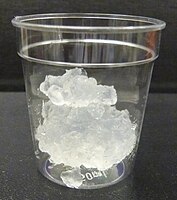
Photo from wikipedia
Abstract. The objective of this study is to prepare a cellulose paper that was impregnated with silver nanoparticles (AgNPs) for the purpose of water purification (disinfection and filtration). AgNP papers… Click to show full abstract
Abstract. The objective of this study is to prepare a cellulose paper that was impregnated with silver nanoparticles (AgNPs) for the purpose of water purification (disinfection and filtration). AgNP papers were prepared by chemical reduction of silver nitrate ( AgNO3 ) with various concentrations (0.005 M , 0.015 M , 0.03 M , and 0.05 M ) using sodium borohydride ( NaBH4 ) as a reducing agent. Two ratios for NaBH 4 / AgNO 3 of 2:1 and 10:1 were used to show the effect of reduction on the formation and removal efficiencies of AgNPs. AgNP papers were characterized using scanning electron microscopy and transmission electron microscopy. An acid digestion using HCl acid followed by analyzing the samples in an atomic absorption spectrometer (ASS) was conducted to measure the silver concentration in AgNP papers. TEM images showed that the silver nanoparticle size in the papers varied from 1.3 to 75 nm . Water samples, after filtration through AgNP papers, were analyzed using ASS to measure the silver concentration in the effluent water. AgNP paper antibacterial efficiency ranged from 99 % to 100 % for both reduction ratios. The average silver content in the effluent water for the three replicates ranged from 0 to 0.082 mg L−1 , which meets the United States Environmental Protection Agency (US-EPA) guideline for drinking water of less than 0.1 mg L−1 . Turbidity tests showed that these papers can be usefully used as point-of-use filters as the turbidity reduced to less than 1 NTU (Nephelometric Turbidity Units).
Journal Title: Drinking Water Engineering and Science
Year Published: 2021
Link to full text (if available)
Share on Social Media: Sign Up to like & get
recommendations!